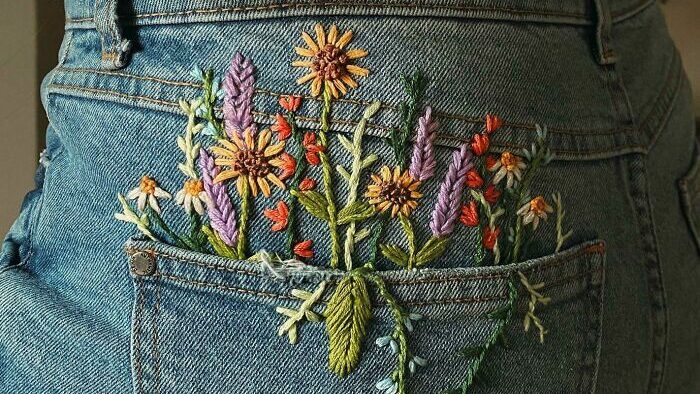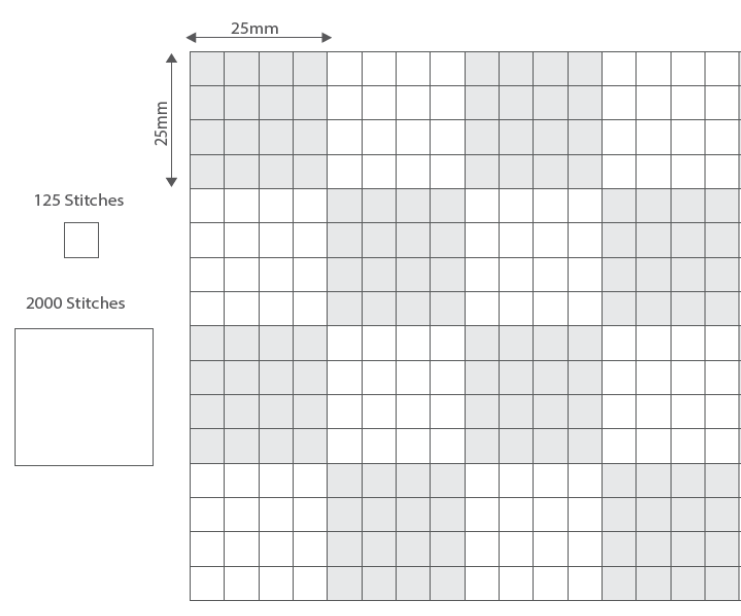
Embroidery, while intricate and beautiful, comes with its own set of challenges, especially when it comes to cost estimation. Often, customers find themselves in a conundrum, trying to figure out how much their dream design might set them back. Enter Blankstyle’s Stitch Count Estimator – a tool that promises to simplify this process.
Embroidery Costs & Stitch Count: Understanding the Connection
The cost of embroidery hinges on several factors, but stitch count stands out as a pivotal determinant. Simply put, the more stitches your design requires, the higher the cost – it’s a reflection of the intricacy and time involved in bringing your design to life. Thankfully, with the advent of tools like the stitch count estimator on blankstyle.com, users can now get an instant quote, providing a clearer picture of potential expenses.
If you’re curious about the number of stitches your logo might entail, simply use our tool. All it requires is for you to upload your logo, and voilà! You’ll receive a stitch count estimation almost instantly.
The Science Behind Stitch Count Estimation
Embroidering isn’t as simple as feeding a design into a machine. First, the artwork must be digitized, a process that translates your design into a language the embroidery machine understands – in stitches. This digitization determines the time, material, and therefore cost, of your embroidery. However, true digitization is an art form, involving time and costs, making it impractical for mere estimations. Hence, stitch count estimation, or educated guessing, comes into play.
Traditional Estimation vs. The New Age Tool
While our tool offers an instant solution, some might wonder about traditional methods. One such method involves “The Grid.”
- Printing the Grid: First, get a printout of the grid from here, which acts as your guide.
- Artwork Placement: Trim your artwork and superimpose it onto the grid, ensuring a perfect alignment.
- Counting Grid Squares: Next, count the grid squares your design occupies. Accuracy is essential for an on-point estimate.
- Consult the Stitch Count Chart: Use the chart provided to correlate the number of grid squares to a potential stitch count.
- Design Extensions: If your logo surpasses the grid, estimate the extra grid space and add this to your initial count.
However, this method has its flaws. Different logos, even of the same size, can vary significantly in stitch counts due to density differences. That’s where the Blankstyle Stitch Count Estimator offers an edge – providing a more accurate estimate digitally.
Factors to Consider for Accurate Estimation
- Solid Inch Equivalents: Typically, a solid square inch of embroidery equals about 2,000 stitches.
- Quarter-Inch Estimation: A quarter-inch of solid embroidery approximates to 125 stitches.
- Letter Size: No letter should be below 3/16″ in height, with each quarter-inch height requiring about 100 stitches.
- Drop Shadows & Lines: These can add around 200 stitches per inch.
- Material Factors: Fabric type, color nuances, and design intricacies can sway the stitch count.
Final Thoughts
With Blankstyle’s Stitch Count Estimator, gone are the days of ambiguous embroidery cost estimations. This user-friendly tool, combined with the knowledge provided above, ensures you’re well-equipped to make informed decisions about your next embroidery project. Happy embroidering!
Blankstyle’s New Tool: The Stitch Count Estimator
Embroidery, while intricate and beautiful, comes with its own set of challenges, especially when it comes to cost estimation. Often, customers find themselves in a conundrum, trying to figure out how much their dream design might set them back. Enter Blankstyle’s Stitch Count Estimator – a tool that promises to simplify this process.
Embroidery Costs & Stitch Count: Understanding the Connection
The cost of embroidery hinges on several factors, but stitch count stands out as a pivotal determinant. Simply put, the more stitches your design requires, the higher the cost – it’s a reflection of the intricacy and time involved in bringing your design to life. Thankfully, with the advent of tools like the stitch count estimator on blankstyle.com, users can now get an instant quote, providing a clearer picture of potential expenses.
If you’re curious about the number of stitches your logo might entail, simply use our tool. All it requires is for you to upload your logo, and voilà! You’ll receive a stitch count estimation almost instantly.

The Science Behind Stitch Count Estimation
Embroidering isn’t as simple as feeding a design into a machine. First, the artwork must be digitized, a process that translates your design into a language the embroidery machine understands – in stitches. This digitization determines the time, material, and therefore cost, of your embroidery. However, true digitization is an art form, involving time and costs, making it impractical for mere estimations. Hence, stitch count estimation, or educated guessing, comes into play.
Traditional Estimation vs. The New Age Tool
While our tool offers an instant solution, some might wonder about traditional methods. One such method involves “The Grid.”
- Printing the Grid: First, get a printout of the grid from here, which acts as your guide.
- Artwork Placement: Trim your artwork and superimpose it onto the grid, ensuring a perfect alignment.
- Counting Grid Squares: Next, count the grid squares your design occupies. Accuracy is essential for an on-point estimate.
- Consult the Stitch Count Chart: Use the chart provided to correlate the number of grid squares to a potential stitch count.
- Design Extensions: If your logo surpasses the grid, estimate the extra grid space and add this to your initial count.
However, this method has its flaws. Different logos, even of the same size, can vary significantly in stitch counts due to density differences. That’s where the Blankstyle Stitch Count Estimator offers an edge – providing a more accurate estimate digitally.
Factors to Consider for Accurate Estimation
- Solid Inch Equivalents: Typically, a solid square inch of embroidery equals about 2,000 stitches.
- Quarter-Inch Estimation: A quarter-inch of solid embroidery approximates to 125 stitches.
- Letter Size: No letter should be below 3/16″ in height, with each quarter-inch height requiring about 100 stitches.
- Drop Shadows & Lines: These can add around 200 stitches per inch.
- Material Factors: Fabric type, color nuances, and design intricacies can sway the stitch count.
Final Thoughts
With Blankstyle’s Stitch Count Estimator, gone are the days of ambiguous embroidery cost estimations. This user-friendly tool, combined with the knowledge provided above, ensures you’re well-equipped to make informed decisions about your next embroidery project. Happy embroidering!
Embroidery, while intricate and beautiful, comes with its own set of challenges, especially when it comes to cost estimation. Often, customers find themselves in a conundrum, trying to figure out how much their dream design might set them back. Enter Blankstyle’s Stitch Count Estimator – a tool that promises to simplify this process.
Embroidery Costs & Stitch Count: Understanding the Connection
The cost of embroidery hinges on several factors, but stitch count stands out as a pivotal determinant. Simply put, the more stitches your design requires, the higher the cost – it’s a reflection of the intricacy and time involved in bringing your design to life. Thankfully, with the advent of tools like the stitch count estimator on blankstyle.com, users can now get an instant quote, providing a clearer picture of potential expenses.
If you’re curious about the number of stitches your logo might entail, simply use our tool. All it requires is for you to upload your logo, and voilà! You’ll receive a stitch count estimation almost instantly.
The Science Behind Stitch Count Estimation
Embroidering isn’t as simple as feeding a design into a machine. First, the artwork must be digitized, a process that translates your design into a language the embroidery machine understands – in stitches. This digitization determines the time, material, and therefore cost, of your embroidery. However, true digitization is an art form, involving time and costs, making it impractical for mere estimations. Hence, stitch count estimation, or educated guessing, comes into play.
Traditional Estimation vs. The New Age Tool
While our tool offers an instant solution, some might wonder about traditional methods. One such method involves “The Grid.”
- Printing the Grid: First, get a printout of the grid from here, which acts as your guide.
- Artwork Placement: Trim your artwork and superimpose it onto the grid, ensuring a perfect alignment.
- Counting Grid Squares: Next, count the grid squares your design occupies. Accuracy is essential for an on-point estimate.
- Consult the Stitch Count Chart: Use the chart provided to correlate the number of grid squares to a potential stitch count.
- Design Extensions: If your logo surpasses the grid, estimate the extra grid space and add this to your initial count.
However, this method has its flaws. Different logos, even of the same size, can vary significantly in stitch counts due to density differences. That’s where the Blankstyle Stitch Count Estimator offers an edge – providing a more accurate estimate digitally.
Factors to Consider for Accurate Estimation
- Solid Inch Equivalents: Typically, a solid square inch of embroidery equals about 2,000 stitches.
- Quarter-Inch Estimation: A quarter-inch of solid embroidery approximates to 125 stitches.
- Letter Size: No letter should be below 3/16″ in height, with each quarter-inch height requiring about 100 stitches.
- Drop Shadows & Lines: These can add around 200 stitches per inch.
- Material Factors: Fabric type, color nuances, and design intricacies can sway the stitch count.
Final Thoughts
With Blankstyle’s Stitch Count Estimator, gone are the days of ambiguous embroidery cost estimations. This user-friendly tool, combined with the knowledge provided above, ensures you’re well-equipped to make informed decisions about your next embroidery project. Happy embroidering!
